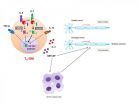The results could help scientists fine-tune medications that manipulate microtubules to treat cancer and other diseases. Rice theoretical biophysicist Anatoly Kolomeisky and postdoctoral researcher Xin Li reported their results in the Journal of Physical Chemistry B.
Microtubules are cylinders made of 13 protein strands and are one of several components of a cell's cytoskeleton. Motor proteins walk along these bundles to deliver cargoes to various parts of a cell and to discard trash. Microtubules also play a part in cell division, movement and signaling.
Cells constantly build, destroy and rebuild these cylinders and reuse the molecular blocks like Legos. "One of the most interesting phenomena associated with microtubules is this dynamic instability," Kolomeisky said. "When you look at them in cells or in vitro, they grow and grow, and suddenly start to shrink without any change in the external conditions. Then suddenly, they start to grow again."
This instability is essential to cellular processes. "If the cell stabilizes, it dies," said Kolomeisky, a professor of chemistry and of chemical and biomolecular engineering at Rice. In fact, he said, the goal of many drugs that target microtubules aim to stabilize growth so a cell stops functioning before it can reproduce. That's important in the fight against cancer, he said.
Microtubules are considered stationary when caps form to prevent them from disassembling. "The important thing we realized is that the microtubule's dynamics -- how and when it approaches a stationary state -- could depend on initial conditions," Kolomeisky said. "If you start from a very long polymer seed, it will take longer to reach a stationary state than if you start with a very short seed."
The seeds form in the cell's microtubule-organizing center, the centrosome. Microtubule strands assemble from subunits of alpha and beta tubulin proteins that form dimers. These dimers each bind two molecules of guanosine triphosphate (GTP). Beta tubulins can selectively (and reversibly) allow GTP to hydrolyze; they take on water to become guanosine diphosphate (GDP).
While reaching for their stationary state, which can take as little as 10 seconds, microtubules are in constant flux - either in a state of "catastrophe" (shrinking) or "rescue" (growing) - until they are capped.
Dimers with GDP easily fall away from the strand, but can't pop out of the middle. So when GTP molecules at the growing end fail to hydrolyze, they effectively cap the strand. GTP "islands" in the middle can also stop a catastrophe in progress and allow the strand to start growing again. The researchers' models of single microtubule filaments were able to predict when and how unhydrolyzed islands of subunits form.
The researchers looked at seeds that have either all GTP or all GDP subunits and found each strongly influences all phases of microtubule growth. They determined that where a seed contained only GTP subunits, all possible subunit configurations came into existence during the growing phase and the rate of catastrophes increased with time, as seen in experiments. The opposite was true for seeds with GDP subunits, for which the catastrophe rate started large and decreased over time.
The research is the first reported product of a program introduced by Kolomeisky and Li earlier this year to analyze the cytoskeleton, including actin and other fibers, from the molecular level up to discover the mechanisms that dictate its behavior.
Microtubules, which can be stable for minutes or even hours, were a good first target, Kolomeisky said, because many experimentalists saw their growth, stability and dissolution as a one-way process and were hard-pressed to explain signs of shrinking along the way.
He said most theoretical investigations of microtubules have only looked at their stationary states, or assumed the breakdown of a microtubule happened all at once. "A proper description of these phenomena must take time into account," he said. "You start from a small polymer seed and see how it grows. That's what we did, and it's given us the first theoretical paper to provide a fully dynamic description of how microtubules grow."
INFORMATION:
The Welch Foundation, the National Science Foundation and Rice's Center for Theoretical Biological Physics supported the research.
Read the abstract at http://pubs.acs.org/doi/abs/10.1021/jp507206f
This news release can be found online at http://news.rice.edu/2014/11/24/cells-skeleton-is-never-still/
Follow Rice News and Media Relations via Twitter @RiceUNews
Related Materials:
Kolomeisky Research Group: http://python.rice.edu/~kolomeisky/
Center for Theoretical Biological Physics: http://ctbp.rice.edu
Images for download:
http://news.rice.edu/wp-content/uploads/2014/11/1124_TUBULE-1-WEB.jpg
A microscopic image of fluorescent endothelial cells shows a network of microtubules in green. Microtubule growth and aging are the topic of new theoretical research at Rice University. (Credit: Wikipedia)
http://news.rice.edu/wp-content/uploads/2014/11/1124_TUBULE-2-WEB.jpg
Rice University researchers Anatoly Kolomeisky, left, and Xin Li are studying the life spans of microtubules, essential elements of living cells' cytoskeletons, to understand how and why the microtubules rapidly grow and shrink as they edge their way toward stability. (Credit: Jeff Fitlow/Rice University)
http://news.rice.edu/wp-content/uploads/2014/11/1124_TUBULE-3-WEB.jpg
Rice University scientists are using custom software to help explain the dynamic instability seen at all times in microtubules, essential elements of a cell's cytoskeleton. The individual elements are protein dimers attached to either guanosine triphosphate (GTP) in red or guanosine diphosphate (GDP) in blue. Clusters of GTP-binding molecules serve as caps that slow or stop microtubules from dissolving. (Credit: Xin Li/Rice University)
Located on a 300-acre forested campus in Houston, Rice University is consistently ranked among the nation's top 20 universities by U.S. News & World Report. Rice has highly respected schools of Architecture, Business, Continuing Studies, Engineering, Humanities, Music, Natural Sciences and Social Sciences and is home to the Baker Institute for Public Policy. With 3,920 undergraduates and 2,567 graduate students, Rice's undergraduate student-to-faculty ratio is just over 6-to-1. Its residential college system builds close-knit communities and lifelong friendships, just one reason why Rice is highly ranked for best quality of life by the Princeton Review and for best value among private universities by Kiplinger's Personal Finance. To read "What they're saying about Rice," go here.
Mike Williams
713-348-6728
mikewilliams@rice.edu




